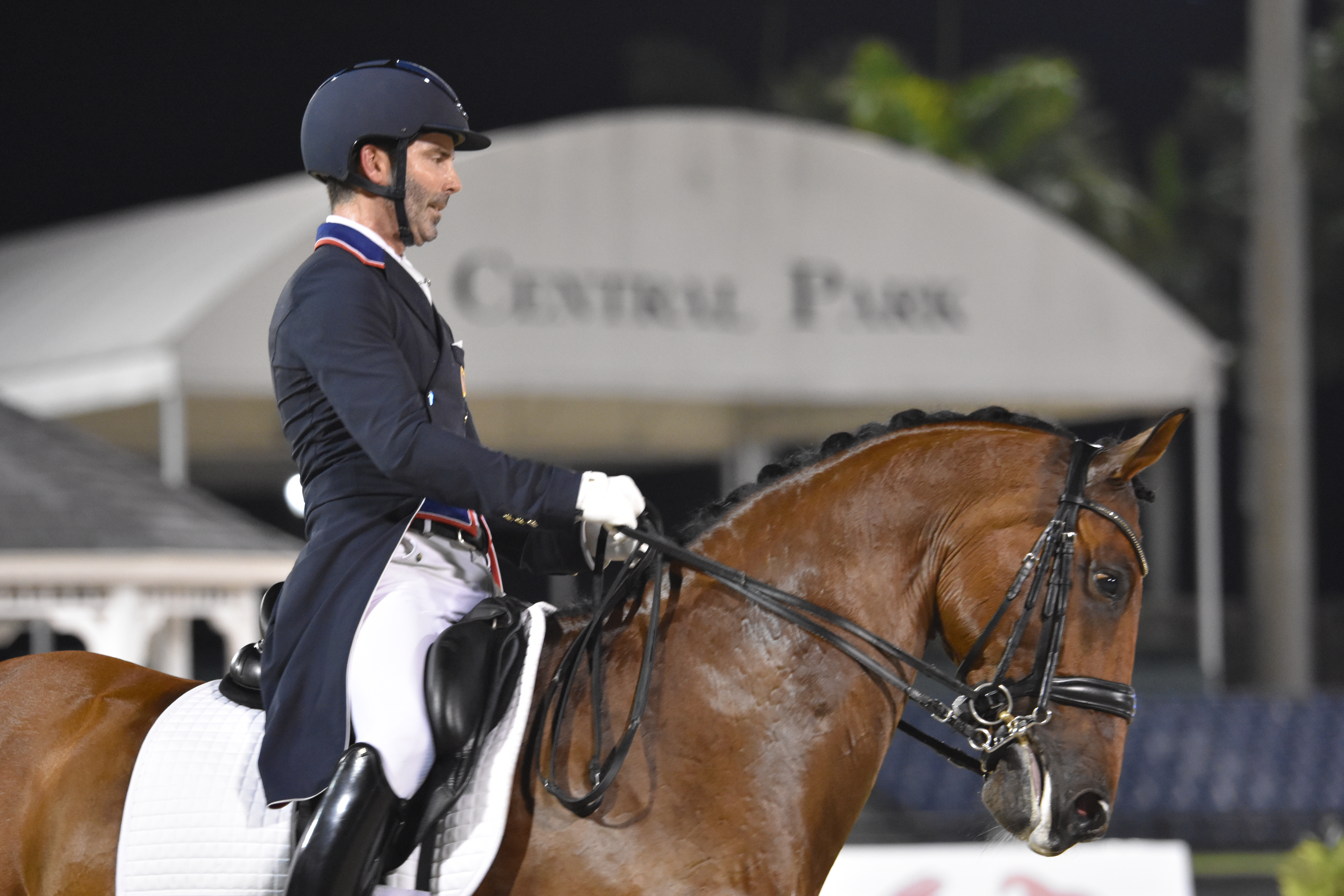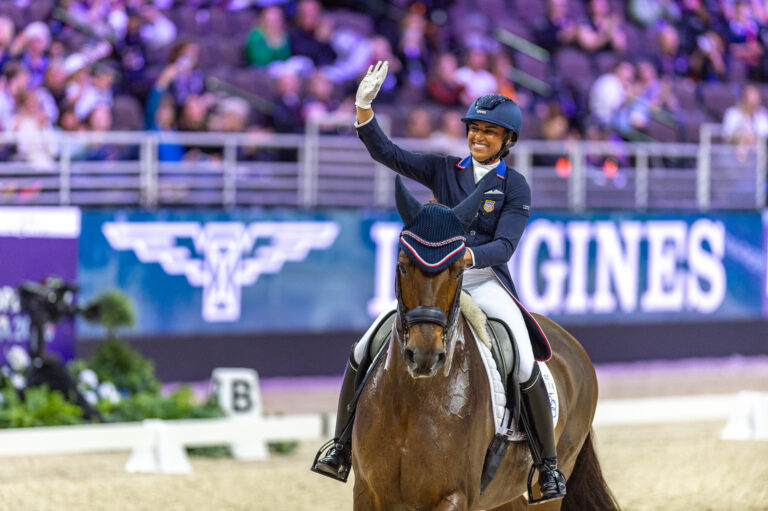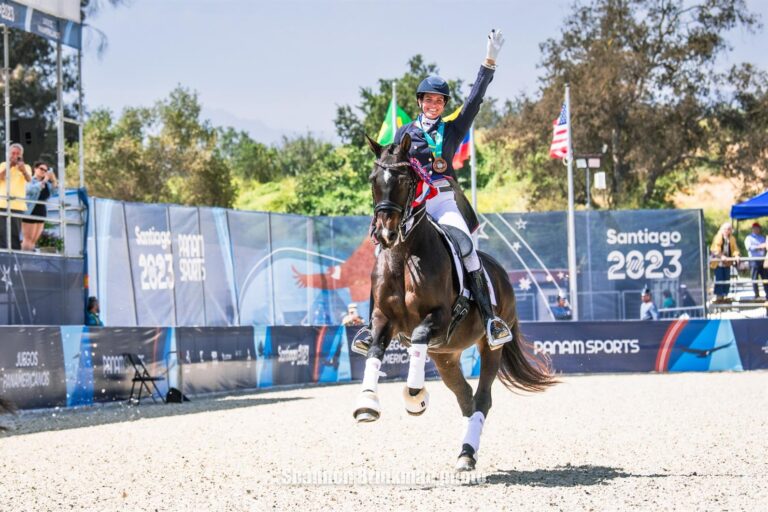
Nick Wagman, based in San Diego, California, was one of three riders to have two horses qualify for U.S. Equestrian’s Dressage Mandatory Observation Event held from June 9 through June 11 at the Palm Beach International Equestrian Center in Wellington, Florida. It’s an accomplishment to qualify with one horse, but something truly special to qualify with two. He talked to Dressage Today Content Manager Stephanie J. Ruff about both horses and what it’s been like to compete them.
Stephanie Ruff: One of the things that struck me is you are one of several people who have two horses here. What is it like trying to get two horses ready and compete them both?
Nick Wagman: It’s a tall order having two horses at an event like this and especially being from California, we’re not used to this weather. We’re managing that with the horses as well as me as the rider. But it’s a prelude to Tokyo potentially so it’s good. They are handling it very well. I think we’re all acclimating. And then the accommodations are great.
Stephanie Ruff: Could you tell us about both your horses?
Nick Wagman: Don John we call DJ. He’s a 2008 Dutch Warmblood gelding owned by Beverly Gepfer. And then Ferano is Ferani, which is not that creative, but that’s it. He’s a 2010 Dutch Warmblood gelding owned by Elizabeth Keadle.
Stephanie Ruff: Were you surprised that you got in with both horses?
Nick Wagman: Don John was the one that I was hopeful with and then to have Ferano join the group was just a great surprise. And a pleasant surprise, of course.
Stephanie Ruff: Do you have any specific healthcare or management routines for them?
Nick Wagman: They are, knock on wood, pretty low maintenance. They’re on a regular routine, and our job is to keep them fit and in condition because they know their jobs well. I think the biggest thing for us was just learning how to accommodate this new climate and then how that was going to impact our training.
Stephanie Ruff: How did you come to get the rides on these two horses?
Nick Wagman: Ferano was purchased as a five-year-old by his current owner (Elizabeth Keadle) as a horse for her. And when he came over five, he was just a little too hot and spooky at the time. So I started him, and then he just kept proving himself to be far more talented than we ever anticipated. And now here we are at the Olympic trials. Elizabeth has just been so supportive and has allowed me to take him as far as I can.
And then Don John was purchased by his current owner (Beverly Gepfer) as a five-year-old as well with the intention of him being a horse for me and hopefully reaching this level. So, it’s exciting that he has done that, and Ferano has done that.

Stephanie Ruff: Does Elizabeth get to ride Ferano?
Nick Wagman: She sat on him once, I think. She keeps saying, “If you do end up going further with Don John and Ferano comes home, maybe his mom can just spoil him and take care of him.” So, I think there’s some rides in there for her.
Stephanie Ruff: What are they like around their barn? Personality wise.
Nick Wagman: They’re both super sociable and really friendly. DJ is in your face all the time and looking for food and treats and loves everybody.
Ferano gives the impression that he’s a little bit cranky, but when you walk away, his ears go forward like “Wait! You get back here.” And then as soon as you’re there, he’s like “I don’t really need you here” and you walk away and then he’s “Wait! Where are you going?” So he’s funny, but they’re both just lovely horses to be around.
Stephanie Ruff: Are they normally stabled together?
Nick Wagman: No. They’ve become travel mates because they’ve been doing the seasons together. And this was cute. Ferano, this time in particular, got a little worried flying from California to Florida, and then as soon as DJ got in the trailer, he was like, “Oh, okay.” And you could just see his whole demeanor changed. But they don’t care when they leave the barn. They’re not attached like that. I think they just know that if they’re both there, they’re doing their jobs.
Stephanie Ruff: What are they like to ride?
Nick Wagman: They are very different. DJ is quite hot and very electric. Ferano is a little more laid back and a slower starter. He has this system where I have to warm up to a certain point, then all of a sudden, he becomes the Grand Prix horse. And you have to allow him that program, whereas DJ comes out and sometimes he’s relaxed enough to go right to work, and sometimes you have to give him a few minutes to just get his squirreliness out.
Stephanie Ruff: How did you figure out their systems?
Nick Wagman: Don John I figured it out the hard way. I had a couple of significant falls from him as a younger horse. So, I’ve learned we just don’t break our routine with him and knock on wood, we’re doing right now. We know each other inside and out.
And Ferano, like I said, from First Level to Grand Prix, he’s always been a slow starter. It doesn’t matter if you’re doing a First Level test or a Grand Prix test, he just needs those 10 minutes to decide that his body’s going to click in. Even on the longe line, for two laps he trots around like a little pony and you’re like, okay, he’s tired. Then suddenly, his tail goes up, and he’s bucking and farting. He just takes that time.
Stephanie Ruff: What are their strengths under saddle?
Nick Wagman: Ferano’s strength certainly is his ability to collect. He’s just a naturally short-coupled, muscular horse, and so the collection for him is pretty solid. And I have to say his brain and his willingness is a strength because on paper he was never meant to really be doing this. Conformationally, he’s not the ideal Grand Prix horse. Kudos to him because he’s learned it all, and at age 11 is doing this. He’s still young, healthy and happy doing his job. I think that says a lot about him as a horse. He’s a remarkable horse.
DJ’s strength is his athleticism. He’s just such an athlete and has so much power in him. He’s one of those rare horses that is hot and sensitive but has the brain to go with it. And that’s a rare combination.

Stephanie Ruff: What are one or two training tips that you did with each horse that really were helpful for each one?
Nick Wagman: I’m a pretty regimented guy in my training routine because I have a full business, so I keep to a schedule, and that seems to work with most of my horses. I like putting them on the longe line every once in a while. A lot of Grand Prix horses don’t get to go on the longe or get time turned out, but they both go on the longe line and get to crack their backs. They get to go in the turnouts. I have to say that, as scary as it is sometimes because we want to keep them in bubble wrap, letting them be horses is probably the number one thing. Every opportunity I can to go and take them out on the property and walk them around and just show them something different is the biggest refresher for all of us.
Stephanie Ruff: Have you had any training challenges with them recently that you had to do any kind of specific work?
Nick Wagman: Challenges? No, it’s more about making sure that they’re fit and healthy. I think when you get to this level, you have to make sure you’re not over schooling out of your own “A” personality type that’s trying to get everything perfect. It’s learning that less is more sometimes and varying the training program. My hurdle has really been not panicking and thinking I’ve got to do more, but to feel prepared and just treating this like a regular horse show as much as possible, which is not easy to do.
Stephanie Ruff: How are you feeling about tomorrow (Friday, June 11) night then?
Nick Wagman: I’m excited. I think usually getting the Grand Prix out of the way gets the nerves out. And then the Special is a fun test.
Stephanie Ruff: The Grand Prix Special will have music with it. Will this be the first time you will have competed with it?
Nick Wagman: Yes. It’ll be interesting because we’re not supposed to technically ride to music. When I first got the music, I listened to it a million times because I just was so excited about it. But then I thought, shoot, I know this too well. And so now, I have not listened to it for quite some time because I don’t want to be so familiar with it that when I hear it, I start to think, “Oh, I’m supposed to be here.” But it’s beautiful music. So I’m excited.
For more exclusive international dressage updates with Vita Flex (http://bit.ly/vita-flex-pro_tokyo) leading up to and including the Games, visit dressagetoday.com/summer-games-2021.











